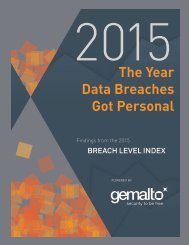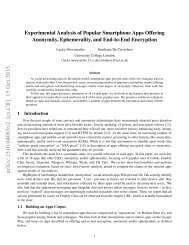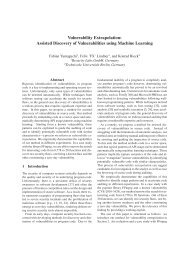Deobfuscating Embedded Malware using Probable-Plaintext Attacks
Deobfuscating Embedded Malware using Probable-Plaintext Attacks
Deobfuscating Embedded Malware using Probable-Plaintext Attacks
Create successful ePaper yourself
Turn your PDF publications into a flip-book with our unique Google optimized e-Paper software.
16 <strong>Deobfuscating</strong> <strong>Embedded</strong> <strong>Malware</strong> <strong>using</strong> <strong>Probable</strong>-<strong>Plaintext</strong> <strong>Attacks</strong><br />
Number of samples<br />
300<br />
250<br />
200<br />
150<br />
100<br />
50<br />
0<br />
0 1 2 3 4 5 6 7 8<br />
Key length<br />
Number of samples<br />
10<br />
8<br />
6<br />
4<br />
2<br />
0<br />
0 1 2 3 4 5 6 7 8 9 10111213141516171819<br />
Number of engines<br />
(a) Detected key lengths<br />
(b) VirusTotal detections<br />
Fig. 8. (a) Distribution of key lengths detected by Kandi; (b) Number of anti-virus<br />
scanners detecting the extracted malware binaries.<br />
As the final step of this experiment, we analyze the extracted malware binaries<br />
with 46 different anti-virus scanners provided by VirusTotal. Since some of<br />
these scanners are prone to errors when it comes to manipulated PE headers,<br />
we consider only those 242 deobfuscated malware binaries that are valid PE files<br />
(conform to the format specification). The number of detections for each of these<br />
files is shown in Figure 8(b). Several binaries are poorly detected by the antivirus<br />
scanners at VirusTotal. For instance, 19% (46) of the binaries are identified<br />
by less than 10 of the available scanners. This result suggests that the extracted<br />
binaries are unkown to a large portion of the anti-virus companies—likely due<br />
to the lack of tools for automatic deobfuscation.<br />
Finally, the analyzed binaries also contain several samples of the MiniDuke<br />
malware discovered in early February 2013 [6]. A few months back, this threat has<br />
been completely unknown, such that we are hopeful that binaries deobfuscated<br />
by Kandi help the discovery of new and previously unknown malware.<br />
5 Limitations<br />
The previous evaluation demonstrates the capabilities of Kandi in automatically<br />
deobfuscating embedded malware. Our approach targets a specific form of<br />
obfuscation and thus cannot uncover arbitrarily obfuscated code in documents.<br />
We discuss limitations resulting from this setting in the following and present<br />
potential extensions of Kandi.<br />
Obfuscation with Other Ciphers. Our approach builds on classic attacks<br />
against Vigenère ciphers. If a different cryptographic cipher is used for the obfuscation,<br />
our method obviously cannot recover the original binary. For example,<br />
the RC4-based obfuscation used in the trojan Taidoor [28] is resistant against<br />
probable-plaintext attacks as used for Kandi. However, the usage of standard<br />
cryptographic primitives, such as RC4 and AES, can introduce detectable patterns<br />
in native code and thereby expose the presence of embedded malware in<br />
documents [see 4]. To stay under the radar of detection tools, attackers need to<br />
carefully balance the strength of obfuscation and its detectability, which provides<br />
room for further cryptographic attacks.









